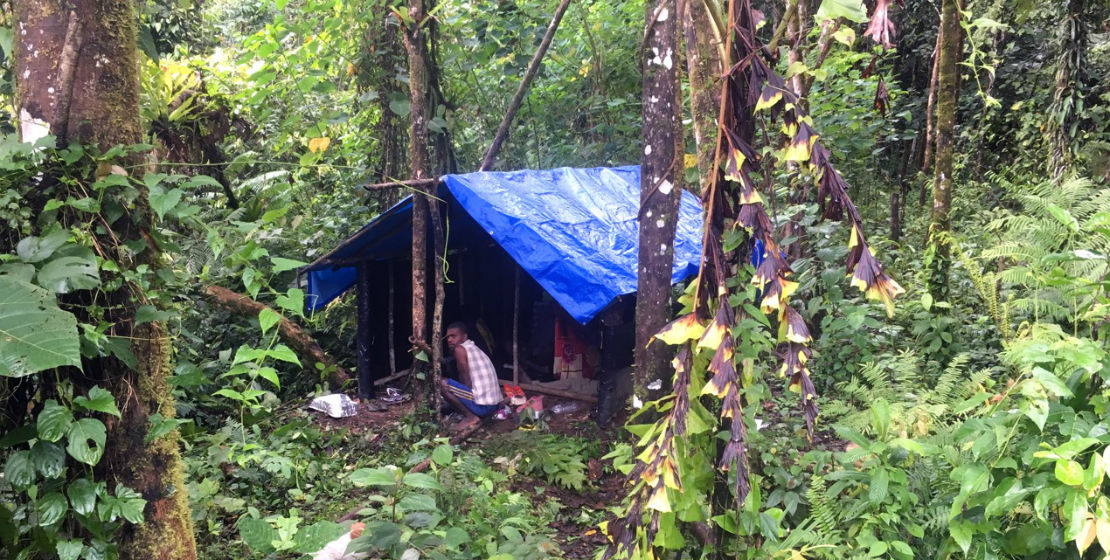
Caption:
This temporary camp at 1000 meters above sea level provided a place to rest and eat before the team headed back down the mountain again.
Credit:
© Tyrone Lavery
Main menu

CEPF is a joint initiative of l’Agence Française de Développement, Conservation International, the European Union, Fondation Hans Wilsdorf, the Global Environment Facility, the Government of Canada, the Government of Japan and the World Bank. A fundamental goal is to ensure civil society is engaged in biodiversity conservation.
Visitez le site français コア情報の日本語翻訳を読むOr use Google Translate to translate the English site to your language:
GTranslate
If a project doesn’t achieve its objective, can it still be a success? Absolutely.
There are three species of giant rat (Uromys sp.) on Guadalcanal in the Solomon Islands. Or at least there were at one time—two of the species haven’t been seen since about 1888.
With CEPF funding, Tyrone Lavery, through the University of Queensland, led a project that aimed to capture images of the elusive rodents. He worked with local landowners to determine the best locations for the cameras and, once every three months or so over the course of 18 months, ventured back across the island to collect the memory cards. This process wasn’t easy: The terrain in some spots was 1,000 meters above sea level. He could get to the most remote sites by helicopter, but then had to walk two days to return for the cameras.
And when he processed the images, what he saw wasn’t encouraging.
“Feral cats were by far the most common species we recorded, even in the places that were a day or two walk from the nearest village,” Lavery said. “People had suspected that two of the three rats may already be extinct as a result of predation by cats. The results of this project have supported that theory.”
In the end, the project didn’t produce a photograph of one single rat. That doesn’t mean Lavery’s efforts were in vain. Along with his local team, Lavery saw indications of where giant rats had been feeding. In fact, through this project he discovered how to tell if the giant rats had been present in an area—valuable intel for potential future efforts.
The findings also reinforced the ecological imbalance on the island. “Even though we did not get photos of the rats, it has been really important to demonstrate what a huge problem the high numbers of feral cats are for conservation,” Lavery said.
Lavery shared the results with the local government and plans to publish the feral cat findings. He also presented the project results during last year’s Oceania Congress for the Society for Conservation Biology in Brisbane.
Originally, Lavery intended that a graduate student lead the project, but, when the student found full-time employment and had to bow out, Lavery took the lead instead. Luckily, he had the help of local community members. That support, though, didn’t come overnight. Lavery has been working on conservation in the Solomon Islands for years.
The conservation division staff at the Ministry of Environment are important contacts that Lavery sees when he visits Honiara. He regularly tries to align his research with what is important to the government and communities by having a conversation about what is important to them. “I ask them what are some of the priorities that they see needing more focus and where I might be able to help with my research abilities and knowledge of mammals,” he said.
Lavery has also made connections with community members whom he met initially through a colleague he was working with on an earlier project.
Acknowledging the deeply rooted insight local people can offer has proved valuable for Lavery. “They have fantastic knowledge of what’s out there in the bush and where to find different species, which was largely how I decided where to put the cameras [for this project].”
There were additional benefits of reaching out to the community. “I tried to spend time on each field trip processing camera trap images with the families that were part of the work,” Lavery said. “This was the most enjoyable part, and I learned a lot about the habits of other species, too.”